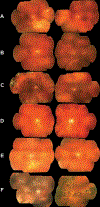Reduced penetrance in a large Caucasian pedigree with Stickler syndrome
- PMID: 28095098
- PMCID: PMC6680000
- DOI: 10.1080/13816810.2016.1275018
Reduced penetrance in a large Caucasian pedigree with Stickler syndrome
Abstract
Background: In a four-generation Caucasian family variably diagnosed with autosomal dominant (AD) Stickler or Wagner disease, commercial gene screening failed to identify a mutation in COL2A1 or VCAN. We utilized linkage mapping and exome sequencing to identify the causal variant.
Materials and methods: Genomic DNA samples collected from 40 family members were analyzed. A whole-genome linkage scan was performed using Illumina HumanLinkage-24 BeadChip followed by two-point and multipoint linkage analyses using FASTLINK and MERLIN. Exome sequencing was performed on two affected individuals, followed by co-segregation analysis.
Results: Parametric multipoint linkage analysis using an AD inheritance model demonstrated HLOD scores > 2.00 at chromosomes 1p36.13-1p36.11 and 12q12-12q14.1. SIMWALK multipoint analysis replicated the peak in chromosome 12q (peak LOD = 1.975). FASTLINK two-point analysis highlighted several clustered chromosome 12q SNPs with HLOD > 1.0. Exome sequencing revealed a novel nonsense mutation (c.115C>T, p.Gln39*) in exon 2 of COL2A1 that is expected to result in nonsense-mediated decay of the RNA transcript. This mutation co-segregated with all clinically affected individuals and seven individuals who were clinically unaffected.
Conclusions: The utility of combining traditional linkage mapping and exome sequencing is highlighted to identify gene mutations in large families displaying a Mendelian inheritance of disease. Historically, nonsense mutations in exon 2 of COL2A1 have been reported to cause a fully penetrant ocular-only Stickler phenotype with few or no systemic manifestations. We report a novel nonsense mutation in exon 2 of COL2A1 that displays incomplete penetrance and/or variable age of onset with extraocular manifestations.
Keywords: Linkage; Stickler syndrome; Wagner syndrome; penetrance.
Conflict of interest statement
Declaration of interest
The authors report no conflicts of interest. The authors alone are responsible for the content and writing of this article.
Figures




Comment in
-
Type I membranous anomaly in Stickler syndrome.Ophthalmic Genet. 2018 Jan-Feb;39(1):147. doi: 10.1080/13816810.2017.1326510. Epub 2017 May 30. Ophthalmic Genet. 2018. PMID: 28557656 No abstract available.
References
-
- Stickler GB, Belau PG, Farrell FJ, et al. Hereditary progressive arthro-ophthalmopathy. Mayo Clin Proc 1965;40:433–455. - PubMed
-
- Printzlau A, Andersen M. Pierre Robin sequence in Denmark: a retrospective population-based epidemiological study. Cleft Palate Craniofac J 2004;41:47–52. - PubMed
-
- Fertala A, Ala-Kokko L, Wiaderkiewicz R, Prockop DJ. Collagen II containing a Cys substitution for arg-alpha1–519. Homotrimeric monomers containing the mutation do not assemble into fibrils but alter the self-assembly of the normal protein. J Biol Chem 1997;272:6457–6464. - PubMed
MeSH terms
Substances
Supplementary concepts
Grants and funding
LinkOut - more resources
Full Text Sources
Other Literature Sources
Medical
